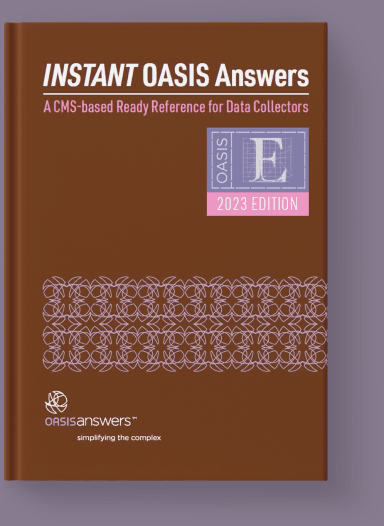NEW Home Health OASIS-based Outcome Measure: Discharge Function Score
The new Home Health OASIS-based outcome measure, Discharge Function Score, is planned to be publicly reported on Care Compare in January 2025, or as soon as technically feasible. Although public reporting begins in less than a year, data collection on this measure has been on-going since for years!
Did you know that there are eleven OASIS GG items that are included in calculations to measure your patient’s functional status for this outcome measure? Additionally, it is important to remember that OASIS accuracy may impact your agency’s quality measure results.
Let’s review how these functional OASIS items are used to calculate the Discharge Function Score.
GG Function Item Set and item Response Codes
The function item set that is used to calculate the Discharge Function Score includes, three GG0130 self-care items: eating, oral hygiene, and toileting hygiene; and eight GG0170 mobility items: roll left and right, lying to sitting on side of bed, sit to stand, chair/bed-to chair transfer, toilet transfer, walk 10 feet, walk 50 feet with 2 turns and wheel 50 feet with 2 turns.
| Item | Item Description |
| GG0130A | Eating |
| GG0130B | Oral Hygiene |
| GG0130C | Toileting Hygiene |
| GG0170A | Roll Left and Right |
| GG0170C | Lying to Sitting on Side |
| GG0170D | Sit to Stand |
| GG0170E | Chair/Bed-to-Chair Transfer |
| GG0170F | Toilet Transfer |
| GG0170I | Walk 10 Feet |
| GG0170J | Walk 50 Feet with 2 Turns |
| G0170R | Wheel 50 Feet with 2 Turns |
Valid responses to code these items include responses 01-06, indicating the patient’s functional status was assessed. Four responses, 07, 09, 10 and 88, along with skipping these items or entering a dash (-), indicate that the functional activity was not attempted/assessed.
| Category | GG Items Response | Response Description |
| Patient Functional Status Assessed | 06 | Independent |
| 05 | Setup or clean-up assistance | |
| 04 | Supervision or touching assistance | |
| 03 | Partial/moderate assistance | |
| 02 | Substantial/maximal assistance | |
| 01 | Dependent | |
| Activity Not Attempted (ANA) codes | 07 | Patient refused |
| 09 | Not applicable | |
| 10 | Not attempted due to environmental limitations | |
| 88 | Not attempted due to medical condition or safety concerns | |
| Other NA codes | ^ | Skip pattern |
| – | Not assessed/no information |
Calculating a Discharge Function Score Using GG items
The Discharge Function Score calculates the percent of home health patients who achieve a risk adjusted expected function score at discharge (Discharge Function Score Measure (Home Health) – Technical Report 2024). The OASIS response numbers from select GG0130 Self-Care and GG-0170 Mobility activities are used to calculate the measure.
Your agency’s score is then calculated by dividing the numerator (the number of quality episodes in that reporting period for the agency with an observed discharge function score for the GG items that is equal to or higher than the calculated expected discharge function score) by the denominator ( the total number of home health quality episodes with an OASIS discharge record in the reporting period, which do not meet the exclusion criteria).
Coding the GG activities with response codes 1-6 indicates that those activities were assessed. For the Discharge Function Score measure calculation, if any GG activity, is not coded with a performance code of 1-6 and instead is coded with an activity not attempted code of 7, 9, 10, 88, or is dashed (-), or is skipped or missing, then statistical imputation is used to estimate the score for that item.
To accurately reflect your patient’s functional status, agencies may wish to reduce the use of the activity not attempted codes when possible.
Reminders for coding the OASIS GG items
To accurately calculate a Discharge Function Score for the patients at your agency, these OASIS coding tips, that can be found in the CMS OASIS-E Guidance Manual Outcome and Assessment Information Set OASIS-E Manual (cms.gov):
- One clinician does take responsibility for the completion of the comprehensive assessment, but they can elicit feedback from other agency staff acting within their scope of practice and can consider input from other sources.
- Observation, interview, collaboration, and assessment of similar activities and other relevant strategies can be used to complete any and all OASIS items as needed.
- Use of an activity not attempted code should occur only after determining that the activity was not completed, and that the performance code cannot be determined based on any of the strategies above.
Learn about these and more valuable OASIS coding tips at an upcoming Blueprint for OASIS Accuracy workshop.
___
Stay up to date on new CMS information related to HHVBP and OASIS accuracy.
- Follow OASIS Answers on Facebook, Instagram, or LinkedIn,
- Sign up for our email list for regular updates and resources








